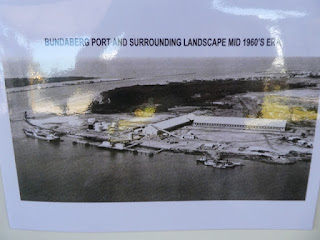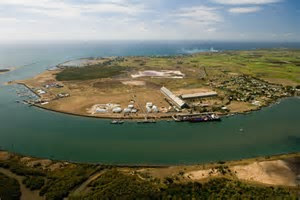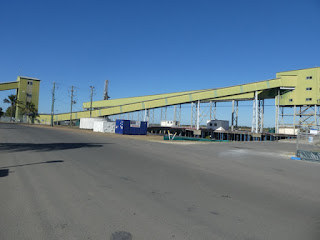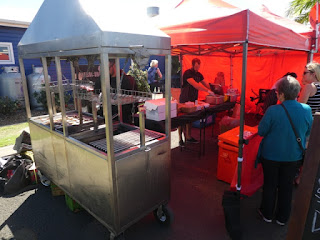Now it has been argued by many that your scribe is a man of varied talents, but let me assure you (with refreshing honesty) a mastery of things mechanical is not among them. I shall be the first to freely admit that if it can't be fixed with a willingly wielded hammer, I am invariably out of my depth. So, dear readers, let me begin this missive with news of an miracle......I actually managed to successfully achieve something significant under the bonnet of our long suffering Cruiser.
Regular readers will be aware of the problems of the past in relation to our fuel filter, in particular the unwelcome appearance of a dashboard warning light which indicates that it is full of water.
Regular readers will be aware of the problems of the past in relation to our fuel filter, in particular the unwelcome appearance of a dashboard warning light which indicates that it is full of water.
With the wonderful assistance of our friends at Robertson Toyota in Gladstone, I am now able to empty out the offending H2O and reset the light, but this was not the end of the problem. On the few days preceding our arrival into Burnett Heads, any sudden thrust on the throttle, particularly when heading up an incline, would result in the activation of the fuel filter warning light. I was over it, well and truly over it. There had to be an answer.
The only thing which made any sense to me was the thought that the filter itself was so clogged with other gunk that it was not doing its assigned task efficiently. We always carry a spare, and after a crash course in filter replacement, thanks to the ever reliable Google, I was prepared to have a crack.
Needless to say the news of this proposal was greeted with an interesting (but probably understandable) reaction from my co-pilot, and I shall happily admit to a degree of nervousness, but my confidence was bolstered by the thought that Marcus, who is a self taught genius when it comes to these things, would undoubtedly be looking over my shoulder.
It was time to take the plunge. With a heart rate nearing 150, I removed the bolts which hold the filter housing top and off it came (without watching any of the bolts disappear into the bowels of the motor below...the first miracle). Who said using an Allen key was hard?
When I eased out the filter its appearance produced a surge of pride.....I had been right about something belonging in an engine for the first time in my life! As you can readily see, it was absolutely filthy. The usually light coloured material of the filter itself was black.
My recently arrived supervisor agreed that this was not a good look in filters, and with an amazing minimum of fuss I eased the new one into place,
refitted the top housing, bled the fuel through the attached lines to prevent any air lock in the system, took another very deep breath and fired up the engine. Never has the clattering rumble of these eight cylinders sounded so sweet. And folks, I can proudly report that not only did this fix the immediate problem, the performance of our tug improved immediately....I am now convinced that the filter was so filthy it was starving the engine of a proper fuel injection.
What an auspicious start this was to a day which turned out to be a real cracker. The hooting sou'-easter had eased. It was time to take a walk around the expanses of the nearby 'port' of Bundaberg, aka the east bank of the Burnett River.
And here comes that word again....perspective, this time thanks to 'dredgingtoday' for this aerial view. As you can see, the river curves inland from its dredged (constantly) mouth. The small boat marina is nearest the entrance, followed by a couple of docking areas for local fishing trawlers, before we come to the much larger infrastructure which is the sugar loading wharf and warehouse complex. Just beyond that lies the housing estate which includes the riverside home belonging to our hosts.
Quite coincidentally, we found ourselves visiting this area on the one Sunday of the year on which the marina area was to come alive with its famed Bundaberg 'Oceanfest'. This was all due to kick off in the late morning, so we though an early ramble though the port district before it was crawling with revellers would be a smart move.
'Port' is a word I normally associate with a marine facility of some size. This is very much not the case here. The presence of the tugs lying alongside their berths did indicate that vessels of some size must use this facility,
and the nearby bulk of the sugar loading dock confirmed this, but this was all there was to it.
I was disappointed that the wharf was empty. It would have been grand to see a large ship moored here in the river (or even better, being manoeuvred alongside), but a visit to the relevant harbour movement website had confirmed that I was doomed to disappointment in that regard. Two vessels can be accommodated at once at this facility, but there is an overall limit of 200 metres on the length of any ship entering this port.
But again the Internet has come to my rescue. With thanks to 'news-mail' this photo shows the size of the bulk carriers which tie up here
to be loaded with raw sugar stored in the adjacent two warehouses
via the conveyor system which stretches high across the underlying roadway.
Finding all this did solve one mystery, that of the constant truck movement we had seen since our arrival. These were the delivery vehicles
which streamed in and out of the access roadway dumping a continuing flow of the bulk raw sugar which was to be loaded onto the carriers. It is no wonder that during the processing seasons these trucks are busy....the two storage sheds here can hold 380,000 tonnes of raw sugar.
Molasses, another product of the local mills, is also stored in large tanks next to the warehouse, but it was in an area opposite these that we came across something completely unexpected.
This large heap of white granular material looked for all the world like sand, and that's exactly what is was. This discovery,
and the sight of more huge dumps of similar looking material across the broad, open spaces which are typical of this port, prompted some later enquiries with mine host.
It was then that I learnt of another of Bundaberg's significant industries, and came across the name 'Sunstate Sands'. So from coal and cattle we have now come to the land of sugar and sand.
About 20 kms south of 'Rum city', on the banks of the Coonarr Creek, a massive mining operation is in full swing, as this photo lifted with gratitude from the company website clearly demonstrates. And what they extract here is good stuff. This mineral sand mine covers over 420 hectares
and contains resources estimated to be in the order of 480,000 tonnes. And that's not the end of it.
The sand here is unusual in that it is 99.8% pure silicon dioxide. It contains no traces of sodium, potassium, magnesium, or calcium. Fantastic I hear you enthuse.....what the hell does all that mean?
The sand here is unusual in that it is 99.8% pure silicon dioxide. It contains no traces of sodium, potassium, magnesium, or calcium. Fantastic I hear you enthuse.....what the hell does all that mean?
Well, folks, the purity of these white grains is of an Internationally recognised high standard, much sought after for the manufacture of glass. I had always thought that was the extent to which these sands are put to use. How wrong I was.
Different sized grains and pebbles are put to a wide range of uses and in an extraordinary range of products, including construction and landscaping, playgrounds, epoxy flooring and polished concrete (as anti-slip), foundries and pool filters, to mention but some of them.
This is not the end of large local industry in addition to the sugar. Looking across another broad open space, we could see a building of significance, the Knauf plaster board manufacturing plant.
So, although I may be a little dismissive of one large wharf fostering the name 'port', there is no doubt that large scale industry beyond that of sugar is taking hold in this area.
And, before we leave this precinct, we came across another surprise, this one with a very personal connection.
The Burnett River now hosts the grey bulk of the decommissioned ex-HMAS Tobruk, an erstwhile Australian Navy supply ship.
A nearby plaque in a viewing area provided the story of the ship's service history and her future. So what's all this about a personal connection?
As you may be aware, my younger son is a Navy aviator, normally a Seahawk helicopter pilot, but currently serving as a Qualified Military Flying Instructor at RAAF Pearce in WA. Before he took to the air, Stu completed three years at ADFA (at my insistence) where he gained a BSc in aeronautical design. During the break between his second and third years, he did his first serious stint at sea, six weeks on Tobruk (not a bad idea to ensure that prospective Navy pilots can actually cope at sea!).
This was obviously a somewhat anxious time. An inability to cope in this environment would mean his prospective chosen career could turn pear shaped. Stu had always loved being on the water in my fishing boat, and I had but a few fleeting concerns, but it was a relief to have him later report that he had not only survived some pretty ordinary weather (up to sea state six at one stage....that's rough), but thrived. And one of my most prized filial photos is of young Stu leaning back against the rail of Tobruk with a nonchalant grin of a hardened sailor against the backdrop of Jervis Bay.
But enough of this nostalgia, there was much more to be seen, including this reminder that the Burnett River is home to quite a large fishing fleet, some of which moor nearby whilst other, such as this arriving trawler lie at anchor or alongside further upstream.
And, of course, on waters such as these, there are other fishing folk to be found, feathered in this case. We had been watching the aquatic antics of a local shag for a few minutes and I have to admit to a large slice of photographic luck in capturing a shot of it as it surfaced with what I though to be an impossibly large bream in the hook of its beak. There is no way it could conceivably gulp this down its narrow neck, I thought.
Wrong again! What I could not believe was that, having finally fought this feed down into its crop, this insatiable bird continued fishing! Is it any wonder that the inevitable results at the other end of this food system are the bane of the lives of those who have boats moored here on the river?
Speaking of which, just beyond Tobruk's berth we found a few of the fishing fleet moored against the marina fingers,
beyond which we came to the beginning of the the precinct which houses the main small boat marina, the large fish processing building and boatyards. All was relatively quiet at the moment,
but an hour or so later, this was a vastly different scene as the normally open spaces became clogged with cars
and what had previously been open lawn and roadways
was now a sea of exhibits, food stalls and a festive crowd.
As we arrived in this area for the second time this morning, a joy flight chopper was already in action
and the crowds were flocking in. We were stunned to see just how popular this festival was and the numbers it attracted.
I remain unsure as to the effect that the presence Tobruk has had locally, but one of the first stand we came across was that of the Bundaberg Navy Cadets which appeared to be a very active group.
From here we wandered into the very large building which is home to Ocean Pacific Seafoods. Seafood is the focus of this festival,
as was amply evident as we walked through what is normally a very busy fish processing factory. Today was a day to show off their wares, including this range of fine fish
and serried rows of scallop shells all nestled in beds of sparkling ice.
Despite the 'open house', there was still plenty of processing activity going on. Scallops were being shucked from their shells'
and the prawn production line was packed.
At this end of the building a group of workers was hard at it, peeling the shells from the arriving prawns and grading them into size.
Things were equally busy outside. The back of this processing factory fronts the river where a gangway took all interested
down to a mooring platform where a local trawler
and a crab boat were ostensibly offering fruits of the sea 'direct from the boats'. Ho hum....any expecting discounted prices were in for a rude surprise!
But one of the displays on the crab boat was worth seeing, a mass of the local crustacean icon, the spanner crab. One look at the odd shaped claws of these crabs removes any question as to the how they came to be so named...what odd looking things they are. Here in Queensland where these tropical crabs thrive, the annual catch of over 3,500 tonnes is testament to their popularity on the plate.
Back on terra firma, we came across this display which showed one of the commercial nets used in this fishery, especially designed with escape hatches to allow any turtles caught to swim free.
The protection of turtles is big here. Between Burnett Heads and Bundaberg lies the oddly named seaside town of Mon Repos (the name was taken from the original cattle station in the district given the pretentious name of Mon Repos.......French for 'my rest')
Here one can find Australia's largest and best known sea turtle rookery which is home to the greatest concentration of nesting marine turtles on the eastern seaboard. Species which lay their eggs here include loggerhead, flatback and green turtles.
As we had wandered around before the opening of Oceanfest, we had our own personal demonstration of another service unique to this area, well, to Mon Repos at least, where the turtle eggs form an irresistible treat to marauding foxes. Reynard was proving to be a real threat to the survival of the eggs. An ingenious solution had to be found.
Let me introduce one of the Mon Repos fox detector dogs.
We had stumbled across this fine little chap as he was being brought out of his cage by his handlers. In response to my enquiry, this most obliging couple suited up this smart sniffer
and hurled a small soft bait package in between a few parked vehicles whilst keeping our canny canine out of sight. Then it was off the lead and away. This incredible dog ranged about at a serious speed for no more than a minute before his finely developed sense of smell had him baying over his quarry with obvious pride. And then came the most amazing bit of news.....the training bait which had been used had last been scented with fox smell a year ago, with no top ups since. What a dog, and he is one of several which are now keeping the previously marauding foxes at bay in the sands of Mon Repos.
Back to the festivities, where, as we walked along the path behind the seafood factory, the small boat marina was in full view
and I came across another stand which was dear to my volunteering heart, surf lifesavers from the not too distant Moore Park beach.
But whilst various local sporting, volunteer and charity groups took advantage of the festival to advance their respective causes, this bash was really all about food, predominately seafood, but with other goodies available to those so inclined.
For $15 one could walk away from this bustling boutique with a platter of grilled tiger prawns, scallops, chorizo and salsa
whilst across the alley a dutch pancake stall (appropriately orange)
rubbed shoulders with those from which fine cheeses or pantry produce were on offer.
Needless to say a stand bearing the ubiquitous arches which symbolise joy for fast food fanatics was not too far away,
but for me the prize amongst the non-seafood outlets had to go to the wood fired pizza palace where a goodly queue had formed.
These canny cooks had arrived complete with a mobile ATM van which they set up right next door to the kitchen. No excuses now for eschewing a chew on a crunchy crust! Enterprise at its best.
Notwithstanding this variety of other foods on offer, seafood was the focus of the day. Varied venues provided places for its consumption These included the inevitable sponsored posh tent (sorry, marquee)
where invited punters were feted in suitable splendour.
As we strolled past, the local glitterati were beginning to gather in numbers, despite the fact that two tables remained unsold (to the undoubted chagrin of the organisers I'll warrant) .
For those not so privileged, this huge covered area would just have to make do.
Many matrons munched merrily on platters of fresh prawns, whilst others arrived at table armed with fish and chips or other fruits of the sea
sourced from the nearby cafe of the Baltimore Restaurant, purported Burnett Heads' finest.
This august establishment certainly provided a grand menu for the day
for those patronising the take-away shop
or seated in style within. But believe me, this luxury did not come cheaply. The 'seafood tower' which was the centre of the attention of this lucky couple, came at a price of $74.
But wouldn't you just think that for a restaurant which prides itself in fine food and service they could at least employ a signwriter who can spell?
Luxury or low key, prawns were being chomped at the rate of knots, and you are never to young to learn.
Many took full advantage of the beautiful calm and sunny weather and dined al fresco

whilst enjoying the music being provided by various bands sadly sponsored by an organisation completely divorced from the purveyance of fresh seafood! I guess support must be seized wherever it can be found.

Apart from all the food and frolic, the local historical society was pulling its weight (we had previously met a couple involved)

with a stand presenting a fascinating display of old photos

and other bits and pieces relevant to the history of the port's development.

Whilst I may have been a tad disparaging about the concept that a facility containing two berths for ships of far less than Cape or Panamax size can really be called a port, there is no doubt that this area is alive with maritime based activity. Just beyond the playground which was the Oceanfest, yachts on hardstands presented a forest of masts.

Other facilities catered for the repair and refurbishment of much larger vessels both recreational (it must be such a trial to be poor!)

and commercial, so I suppose fairness demands that I acknowledge the practical status of this area as a port, even if small by comparison with most I've seen elsewhere.
So with that somewhat snide smidgen of sagacity I must bid farewell to Burnett Heads and the port of Bundaberg and offer a vote of thanks for the wonderful hospitality we had enjoyed with Kay and Marcus. Yet more travelling friends were awaiting our arrival in the tiny town of Proston, beyond which we had yet another rendezvous arranged, this time in Toowoomba. Life can be busy on the road!































































No comments:
Post a Comment